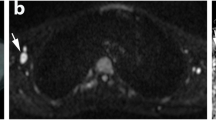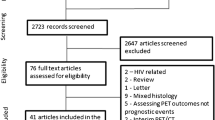Abstract
Purpose
To determine if PET reporting criteria for the Response Adapted Treatment in Hodgkin Lymphoma (RATHL) trial could enable satisfactory agreement to be reached between ‘core’ laboratories operating in different countries.
Methods
Four centres reported scans from 50 patients with stage II–IV HL, acquired before and after two cycles of Adriamycin/bleomycin/vinblastine/dacarbazine. A five-point scale was used to score response scans using ‘normal’ mediastinum and liver as reference levels. Centres read scans independently of each other. The level of agreement between centres was determined assuming (1) that uptake in sites involved at diagnosis that was higher than liver uptake represented disease (conservative reading), and (2) that uptake in sites involved at diagnosis that was higher than mediastinal uptake represented disease (sensitive reading).
Results
There was agreement that the response scan was ‘positive’ or ‘negative’ for lymphoma in 44 patients with a conservative reading and in 41 patients with a sensitive reading. Kappa was 0.85 (95% CI 0.74–0.96) for conservative reading and 0.79 (95% CI 0.67–0.90) for sensitive reading. Agreement was reached in 46 and 44 patients after discussion for the conservative and sensitive readings, respectively.
Conclusion
The criteria developed for reporting in the RATHL trial are sufficiently robust to be used in a multicentre setting.




Similar content being viewed by others
Reference
Hutchings M, Barrington SF. PET/CT for therapy response assessment in lymphoma. J Nucl Med 2009;50:21S–30S.
Gallamini A, Hutchings M, Rigacci L, Specht L, Merli F, Hansen M, et al. Early interim 2-[18F]fluoro-2-deoxy-D-glucose positron emission tomography is prognostically superior to international prognostic score in advanced-stage Hodgkin's lymphoma: a report from a joint Italian-Danish study. J Clin Oncol 2007;25:3746–52.
Hutchings M, Mikhaeel NG, Fields PA, Nunan T, Timothy AR. Prognostic value of interim FDG-PET after two or three cycles of chemotherapy in Hodgkin lymphoma. Ann Oncol 2005;16:1160–8.
Mikhaeel NG, Hutchings M, Fields PA, O'Doherty MJ, Timothy AR. FDG-PET after two to three cycles of chemotherapy predicts progression-free and overall survival in high-grade non-Hodgkin lymphoma. Ann Oncol 2005;16:1514–23.
Horning SJ, Juweid ME, Schoder H, Wiseman G, McMillan A, Swinnen LJ, et al. Interim positron emission tomography (PET) scans in diffuse large B-cell lymphoma: an independent expert nuclear medicine evaluation of the Eastern Cooperative Oncology Group E3404 study. Blood 2010;115:775–7.
Cohen J. A coefficient of agreement for nominal scales. Educ Psychol Meas 1960;20:37–46.
Altman DG. Some common problems in medical research. Practical statistics for medical research. London: Chapman and Hall/CRC; 1999. p. 396–439.
Zijlstra JM, Comans EF, van Lingen A, Hoekstra OS, Gundy CM, Willem Coebergh J, et al. FDG PET in lymphoma: the need for standardization of interpretation. An observer variation study. Nucl Med Commun 2007;28:798–803.
Chiti A. Evaluation of response: is 18F-FDG PET the answer? Eur J Nucl Med Mol Imaging 2009;36:733–4.
Hofman MS, Smeeton NC, Rankin SC, Nunan T, O'Doherty MJ, Hofman MS, et al. Observer variation in FDG PET-CT for staging of non-small-cell lung carcinoma. Eur J Nucl Med Mol Imaging 2009;36:194–9.
Hutchings M, Loft A, Hansen M, Pedersen LM, Buhl T, Jurlander J, et al. FDG-PET after two cycles of chemotherapy predicts treatment failure and progression-free survival in Hodgkin lymphoma. Blood 2006;107:52–9.
Han HS, Escalon MP, Hsiao B, Serafini A, Lossos IS. High incidence of false-positive PET scans in patients with aggressive non-Hodgkin's lymphoma treated with rituximab-containing regimens. Ann Oncol 2009;20:309–18.
Hutchings M, Loft A, Hansen M, Ralfkiaer E, Specht L, Hutchings M, et al. Different histopathological subtypes of Hodgkin lymphoma show significantly different levels of FDG uptake. Hematol Oncol 2006;24:146–50.
Gallamini A, Rigacci L, Merli F, Nassi L, Bosi A, Capodanno I, et al. The predictive value of positron emission tomography scanning performed after two courses of standard therapy on treatment outcome in advanced stage Hodgkin's disease. Haematologica 2006;91:475–81.
Kostakoglu L, Goldsmith SJ, Leonard JP, Christos P, Furman RR, Atasever T, et al. FDG-PET after 1 cycle of therapy predicts outcome in diffuse large cell lymphoma and classic Hodgkin disease. Cancer 2006;107:2678–87.
Querellou S, Valette F, Bodet-Milin C, Oudoux A, Carlier T, Harousseau JL, et al. FDG-PET/CT predicts outcome in patients with aggressive non-Hodgkin's lymphoma and Hodgkin's disease. Ann Hematol 2006;85:759–67.
Juweid ME, Stroobants S, Hoekstra OS, Mottaghy FM, Dietlein M, Guermazi A, et al.; Imaging Subcommittee of International Harmonization Project in Lymphoma. Use of positron emission tomography for response assessment of lymphoma: consensus of the Imaging Subcommittee of International Harmonization Project in Lymphoma. J Clin Oncol 2007;25:571–8.
Meignan M, Gallamini A, Haioun C. Report on the First International Workshop on Interim-PET-Scan in Lymphoma. Leuk Lymphoma 2009;50:1257–60.
Lin C, Itti E, Haioun C, Petegnief Y, Luciani A, Dupuis J, et al. Early 18F-FDG PET for prediction of prognosis in patients with diffuse large B-cell lymphoma: SUV-based assessment versus visual analysis. J Nucl Med 2007;48:1626–32.
Itti E, Lin C, Dupuis J, Paone G, Capacchione D, Rahmouni A, et al. Prognostic value of interim 18F-FDG PET in patients with diffuse large B-cell lymphoma: SUV-based assessment at 4 cycles of chemotherapy. J Nucl Med 2009;50:527–33.
Berthelsen AK, Holm S, Loft A, Klausen TL, Andersen F, Hojgaard L. PET/CT with intravenous contrast can be used for PET attenuation correction in cancer patients. Eur J Nucl Med Mol Imaging 2005;32:1167–75.
Rodriguez-Vigil B, Gomez-Leon N, Pinilla I, Hernandez-Maraver D, Coya J, Martin-Curto L, et al. PET/CT in lymphoma: prospective study of enhanced full-dose PET/CT versus unenhanced low-dose PET/CT. J Nucl Med 2006;47:1643–8.
Elstrom RL, Leonard JP, Coleman M, Brown RKJ. Combined PET and low-dose, noncontrast CT scanning obviates the need for additional diagnostic contrast-enhanced CT scans in patients undergoing staging or restaging for lymphoma. Ann Oncol 2008;19:1770–3.
Barrington SF, O'Doherty MJ. Limitations of PET for imaging lymphoma. Eur J Nucl Med Mol Imaging 2003;30:S117–27.
Karam M, Roberts-Klein S, Shet N, Chang J, Feustel P, Karam M, et al. Bilateral hilar foci on 18F-FDG PET scan in patients without lung cancer: variables associated with benign and malignant etiology. J Nucl Med 2008;49:1429–36.
Hofman MS, Smeeton NC, Rankin SC, Nunan T, O'Doherty MJ. Observer variation in interpreting 18F-FDG PET/CT findings for lymphoma staging. J Nucl Med 2009;50:1594–7.
Fletcher BD, Glicksman AS, Gieser P. Interobserver variability in the detection of cervical-thoracic Hodgkin's disease by computed tomography. J Clin Oncol. 1999;17:2153.
Acknowledgments
The RATHL study is supported by Cancer Research UK. The authors thank Dr. Biggi, Azienda Ospedaliera S. Croce e Carle, Cuneo, Dr Quon, Stanford University, Dr. Juweid, University of Iowa, and Dr. Elstrom, University of Michigan, for contributions to the development of reporting criteria for the RATHL trial.
Conflicts of interest
None.
Author information
Authors and Affiliations
Corresponding author
Rights and permissions
About this article
Cite this article
Barrington, S.F., Qian, W., Somer, E.J. et al. Concordance between four European centres of PET reporting criteria designed for use in multicentre trials in Hodgkin lymphoma. Eur J Nucl Med Mol Imaging 37, 1824–1833 (2010). https://doi.org/10.1007/s00259-010-1490-5
Received:
Accepted:
Published:
Issue Date:
DOI: https://doi.org/10.1007/s00259-010-1490-5




